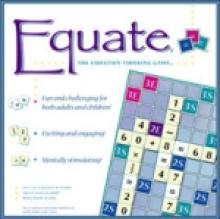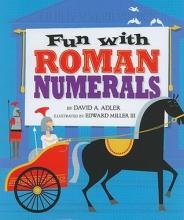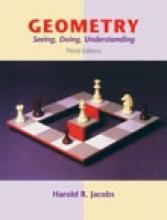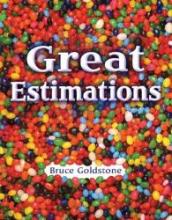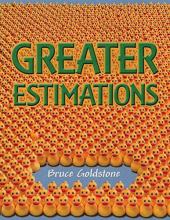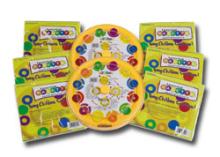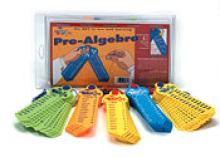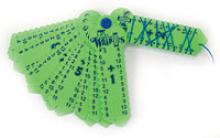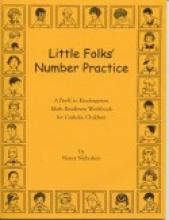Math
Equate: The Equation Thinking Game
Similar in format to the word game Scrabble�, Equate allows players to place equations on a board while gaining points based upon the types of numbers and operations used. (For example, a fraction is worth more points than a whole number and a division symbol is worth more points than an addition symbol. Don't worry - the point value is marked on each tile.) Players may add on to existing equations provided that both sides of the equation are still equal.
We found this to be a fun and challenging game for upper grade school through adult. Add on sets can be purchased for younger grades or for advanced Math (the advanced set also includes negative numbers and exponents). Even with the basic set, level of play can be quite challenging considering equations involving multiplication and division of fractions and order of operation. Rules could easily be adjusted to accomodate players with varying skill levels.
Fun with Roman Numerals
I showed this book and read it aloud to my kids in Junior Classical League's last meeting, and except for one kid, the club's president and a Latin aficionado, none of us knew about the Roman numerals on the two last pages! Have fun learning!
From the publisher:
Page IV, Super Bowl XLV. Built in MMVIII. Roman numerals are everywhere---on clocks, in books, and on buildings. But what do Roman numerals mean, and how does one use them? Fun with Roman Numerals is a straightforward and appealing introduction to a timely topic. On a scale of I to X, it's an XI!
Geometry: Seeing, Doing, Understanding
Saxon is a tried and true mathematics choice for many homeschoolers, but one complaint about the high school level texts Algebra I and Algebra II is that geometry is included piecemeal in the algebra courses rather than being taught separately in a systematic fashion. Jacobs' Geometry is one alternative for those who find this to be a problem. It is a friendly, thorough approach to high school geometry that starts with an introduction to deductive reasoning and takes the student through to non-Euclidean and coordinate geometry.
The format is very appealing, at least to my high-school age son and myself. The book is divided into chapters covering broad topics like Rays and Angles, Congruent Triangles, and Quadrilaterals. These are subdivided into lessons. Each lesson opens with a cartoon or thought puzzle which draws the student into the topic being discussed. There are three sets of problems in each lesson: the first one usually checks comprehension of concepts and knowledge of theorems, the second set is an application of the lesson to proofs, and the third set, usually a single question, presents a brain-teaser which allows the student to think and ponder creatively.
A Letter to the Student at the beginning tells the story of Pythagoras, the Greek geometer, who taught a reluctant student by paying him for each theorem he learned. By the end of the course, the student was paying Pythagoras. The anecdote sets the tone for the whole book, the assumption being that geometry is a noble, worthwhile endeavor and that a student will realize this and be willing to apply himself to mastery.
Though I haven't used the Jacobs' Algebra, the format looks similar to Geometry. My high-schooler is using it now in short sections as a review. With my next high schooler, I am planning to go from Saxon Algebra ½ to Jacobs' Algebra. There is no book in the Jacobs' series after Geometry; the author Harold Jacobs recommends Algebra II and Trigonometry by Paul A Foerster as the next step before Calculus.
Great Estimations
Greater Estimations
You may have enjoyed, like we have, Great Estimations in the past. I was happy to find in the library this week a brand new sequel by the same author!
Greater Estimations deals still with estimations, as as the cover says, it deals with greater estimations. Be prepared for some large numbers, and if you read it aloud it may generate some fun discussions! I had lunch today with my friend and neighbor Mary Daly, the author of the well-known homeschool science program entitled The Universe in My Hands, and over some awesome enchiladas after our bishop's pro-life mass we discussed how so few people have a good grasp of how many a million is. Or even one thousand. We went on to estimate the chips in the basket next to the yummy salsa!
Learning Palette Mathematics
Learning Wrap-Ups, plastic palette and colored discs with self-correcting card sets (This review is based on use of the first and third grade sets).
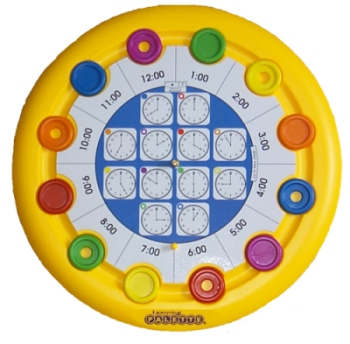 This clever learning tool for young children features an almost 12 inch diameter "palette" which holds a double-sided learning card and 12 different colored discs. A clear plastic lid is included. I have been very impressed with how these palettes hold up under a lot of use (and occasional abuse from babies and toddlers). Each card has pictorial equations or problems on one side. The child matches the correct color/shape disc with the answer he chooses. When finished placing all twelve discs, he can turn the card over and correct the answers himself.
This clever learning tool for young children features an almost 12 inch diameter "palette" which holds a double-sided learning card and 12 different colored discs. A clear plastic lid is included. I have been very impressed with how these palettes hold up under a lot of use (and occasional abuse from babies and toddlers). Each card has pictorial equations or problems on one side. The child matches the correct color/shape disc with the answer he chooses. When finished placing all twelve discs, he can turn the card over and correct the answers himself.
Cards are purchased in sets of 12 (a total of 144 problems since there are 12 problems per page). Math sets are available for first through third grade. There are six card sets available for each of these three grades:
Three sets of Numeration Cards: The numeration sets cover all kinds of basic math operations with an appropriate level of challenge and content.
One set of Algebra Concept Cards: First grade algebra card "challenges" include recognizing missing numbers and finding missing shapes. The third grade cards involve solving for the unknown in addition subtraction, multiplication and division.
One set of Geometry and Measurement Cards: First grade cards cover shape names, volume, calendars, telling time and reading thermometers. The third grade set covers includes problems regarding perimeter, area, geometric forms and terms, simple graphing and units of measurement.
One set of Probability and Statistics Cards: These cards cover topics like "more and less likely" and tallying in the first grade set. The third grade set provides practice in the relationship between fractions and probability, determining the likelihood of an event and using the data from charts to draw conclusions.
I am very impressed with the level of challenge and variety of topics covered at appropriate age-levels (they meet the National Council of Teachers of Mathematics standards). We have found these particularly nice because they offer mental stimulation while taking a break from writing-skills (which can be very taxing on children in the early grades). For example, we used these with my third grade son last year as a supplement to MCP 3rd Grade Math. Some days he would just do Learning Palettes for his Math assignment. (In addition, I had him spend some time doing mazes and other fine-motor skill building activities.) He didn't do every page of the MCP book - instead I let him test out of some of the chapters (he had to achieve a very good score in order to skip the chapter - naturally we had to discuss some concepts as they came up on the Learning Palettes as well).
Investing in the entire line of Learning Palettes can be rather expensive. The Palette itself is about $15 and each card set is $10 (you can buy grade-level groupings of six sets for a little less). I found this investment to be quite worthwhile since the product is non-consumable (and quite sturdy). The material is very straightforward and well thought-out.
Learning Wrap-Ups for Pre-Algebra: Introductory Kit
Each of five sets in this kit have 10 plastic key-shaped cards that fan-out at a pivot point. A sturdy string attached to the pivot point is pulled through a hole in the card. The student then wraps the string from the first problem to the answer, around the back of the card to the next problem, etc. After completing the card, you turn the card over. If the string matches with the lines on the back, all the answers are correct.
The five sets drill the following materials:
Addition & Subtraction of Positive and Negative Numbers Sample problem: (-9)-(-2)=t
Multiplication & Division of Positive and Negative Numbers Sample problem: (-7)x(-12)=p
Solving for the Unknown (Working with Variables) Sample problem: (-42)-z=(-3)
Understanding Algebraic Expressions Sample problem: Given x=7, evaluate 8x-7
Mental Math, Prime Factors, Perfect Squares, Square Roots, Formulas for Area, Perimeter and Volume Sample problem: Find the square root of 289
Our family has enjoyed the Learning Wrap-ups as a nice way to drill facts. I'm impressed with the thought that has gone into the equations. My 6th grade daughter has found this set a little challenging (more appropriate for 7th and 8th grade), but a welcome change from her textbook.
Learning Wrap-Ups: Basic Math Introductory Kit
These colorful key-shaped plastic flash cards allow students to practice basic Math skills by wrapping a string around the ribbed edges of each card to identify the correct answer. (Cards are attached together on a pivot point in groupings of 10 cards organized by operation.) The cards are cleverly self-correcting - when the child finishes each card, they simply flip it over; when all answers are correct, the string will match the diagram on the back of the card. The basic operations sets are simple equations where you match the equation to the correct answer. For the fractions set, you are matching equivalent fractions - pictures to fractions, pictures to pictures and fractions to fractions - plus a few simple equations which involve adding and subtracting fractions.
We have found this to be a great way for our children to practice their basic math facts. They are colorful and appealing and offer a welcome change from regular book-work.
Please note when ordering this product that there are many varieties of this product – some including CDs or workbooks, or even large classroom size sets. The set reviewed here retails for about $45-$50 (in 2024) and contains 5 flash-card sets – Addition, Subtraction, Multiplication, Division and Fractions.
Also see the Learning Wrap Ups website for more details and an animated demo.
Another reviewer (Suchi) notes: One of my sons is a highly visual learner, so much so that he managed to memorize the patterns that the strings made on the fronts of the keys. He could "do" the wrap-ups incredibly fast, but was not actually learning the facts. Parents may want to occasionally check the student's math facts in some other way to ensure that they are really getting learning. The wrap-ups did work well for my other children.
Little Folks' Number Practice
This simple workbook provides practice for preschool and kindergarten aged children in writing numbers, counting objects and considering religious ideas associated with each number (one God, two natures: human and divine, three Divine Persons, four marks of the Church: One - Holy - Catholic - Apostolic, five Sacred Wounds, etc.). There are three pages each for the numbers one through ten which contain writing lines for handwriting practice of the numbers, related black and white illustrations to color, pictures to circle and count, etc. The remaining pages provide practice in counting sets of things ("circle the correct number" for several pages and "write the correct number" for others). The final eight pages offer simple exercises involving numerical order, more and less, some very basic addition and simple shapes. The pages would have to be read aloud to young children.
Copyrights 1997/2002

